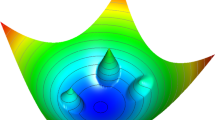Abstract
In this paper, we introduce a formulation for the task of detecting objects based on the information gathered from a standard Implicit Shape Model (ISM). We describe a probabilistic approach in a general random field setting, which enables to effectively detect object instances and additionally identifies all local patches contributing to the different instances. We propose a sparse graph structure and define a semantic label space, specifically tuned to the task of localizing objects. The design of the graph structure then allows to define a novel inference process that efficiently returns a good local minimum of our energy minimization problem. A key benefit of our method is, that we do not have to fix a range for local neighborhood suppression, as necessary for instance in related non maximum suppression approaches. Our inference process implicitly is capable to separate even strongly overlapping object instances. Experimental evaluation compares our method to state-of-the-art in this field on challenging sequences showing competitive and improved results.
Access this chapter
Tax calculation will be finalised at checkout
Purchases are for personal use only
Preview
Unable to display preview. Download preview PDF.
Similar content being viewed by others
References
Viola, P., Jones, M.: Robust real-time face detection. IJCV 57, 137–154 (2004)
Lampert, C.H., Blaschko, M.B., Hofmann, T.: Efficient subwindow search: A branch and bound framework for object localization. IEEE Trans. on PAMI 31, 2129–2142 (2009)
Dalal, N., Triggs, B.: Histograms of oriented gradients for human detection. In: Proc. CVPR (2005)
Fischler, M., Elschlager, R.: The representation and matching of pictorial structures. IEEE Trans. on Computers C-22, 67–92 (1973)
Gall, J., Lempitsky, V.: Class-specific Hough forests for object detection. In: Proc. CVPR (2009)
Felzenszwalb, P.F., Girshick, R.B., McAllester, D., Ramanan, D.: Object detection with discriminatively trained part-based models. IEEE Trans. on PAMI 32, 1627–1645 (2010)
Fergus, R., Perona, P., Zisserman, A.: Weakly supervised scale-invariant learning of models for visual recognition. IJCV 71, 273–303 (2007)
Sivic, J., Zisserman, A.: Video Google: A text retrieval approach to object matching in videos. In: Proc. ICCV (2003)
Leibe, B., Leonardis, A., Schiele, B.: Combined object categorization and segmentation with an implicit shape model. In: Proc. ECCV (2004)
Lehmann, A., Leibe, B., Gool, L.V.: PRISM: PRincipled Implicit Shape Model. In: Proc. BMVC (2009)
Barinova, O., Lempitsky, V., Kohli, P.: On the detection of multiple object instances using Hough transforms. In: Proc. CVPR (2010)
Kolmogorov, V., Zabin, R.: What energy functions can be minimized via graph cuts? IEEE Trans. on PAMI 26, 147–159 (2004)
Boykov, Y., Veksler, O., Zabih, R.: Fast approximate energy minimization via graph cuts. IEEE Trans. on PAMI 23, 1222–1239 (2001)
Andriluka, M., Roth, S., Schiele, B.: People-tracking-by-detection and people-detection-by-tracking. In: Proc. CVPR (2008)
Riemenschneider, H., Sternig, S., Donoser, M., Roth, P.M., Bischof, H.: Hough Regions for Joining Instance Localization and Segmentation. In: Fitzgibbon, A., Lazebnik, S., Perona, P., Sato, Y., Schmid, C. (eds.) ECCV 2012, Part III. LNCS, vol. 7574, pp. 258–271. Springer, Heidelberg (2012)
Ferryman, J., Shahrokni, A.: PETS2009: Dataset and challenge. In: PETS (2009)
Author information
Authors and Affiliations
Editor information
Editors and Affiliations
Rights and permissions
Copyright information
© 2013 Springer-Verlag Berlin Heidelberg
About this paper
Cite this paper
Wohlhart, P., Donoser, M., Roth, P.M., Bischof, H. (2013). Detecting Partially Occluded Objects with an Implicit Shape Model Random Field. In: Lee, K.M., Matsushita, Y., Rehg, J.M., Hu, Z. (eds) Computer Vision – ACCV 2012. ACCV 2012. Lecture Notes in Computer Science, vol 7724. Springer, Berlin, Heidelberg. https://doi.org/10.1007/978-3-642-37331-2_23
Download citation
DOI: https://doi.org/10.1007/978-3-642-37331-2_23
Publisher Name: Springer, Berlin, Heidelberg
Print ISBN: 978-3-642-37330-5
Online ISBN: 978-3-642-37331-2
eBook Packages: Computer ScienceComputer Science (R0)




